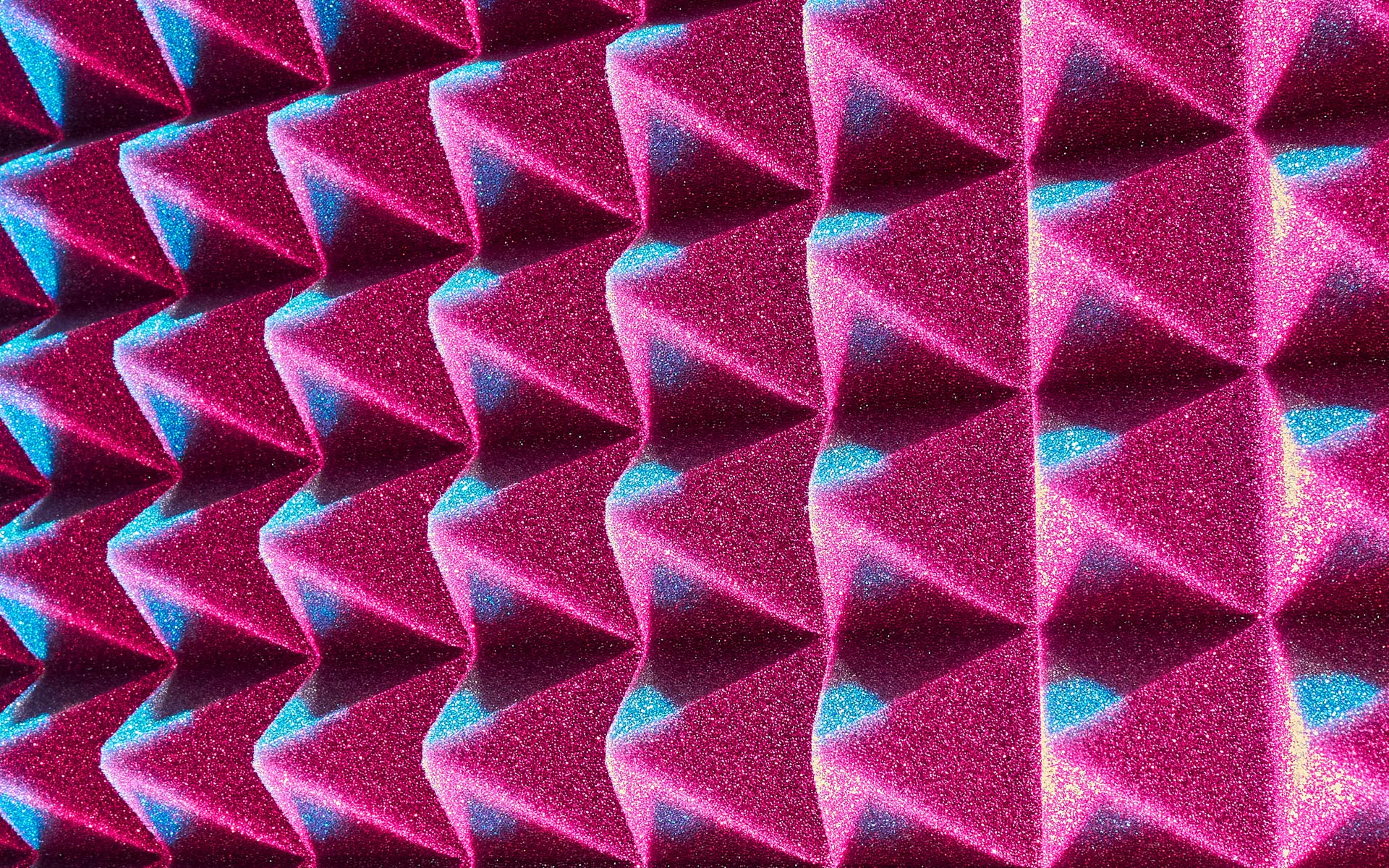The following information on acoustics in music is excerpted from the Berklee Online course Acoustics, written by Eric Reuter, and currently enrolling.
From outdoor amphitheaters, to indoor concert halls, to sound-tight recording studios, an understanding of acoustics is required to design these spaces and ensure they sound their best when they are filled with live music. If you’re looking to become a better sound or recording engineer, acoustics is definitely something you want to wrap your head around. Here are some basic ideas in acoustics to begin your studies, which can be beneficial before diving into the more advanced mathematical concepts.
What is acoustics?
Acoustics is the branch of physics concerned with the study of sound, which is simply anything that humans or other animals can hear. Musicians are primarily concerned with the range of sound that is audible to humans, and that will be the focus of this article.
What is the difference between acoustics and audio?
It is important that we draw a distinction between acoustics and audio. Acoustics is the study of sound in some mechanical form—whether in air or some other medium. In the recording industry, the term “audio” generally refers to an electrical representation of an acoustic signal. Audio is a convenient way to transmit, manipulate, and store sound. However, we are not able to hear audio signals until they have been turned back into acoustic signals. Our experience of sound is always acoustic, regardless of whether electronics were involved in the path from the source to our ears.
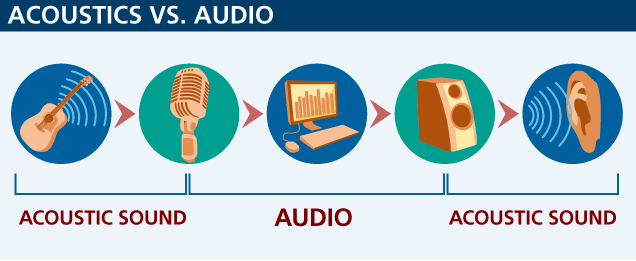
Practitioners of acoustics, or acousticians, want to understand how sound impacts a listener, we look at the path that the sound has taken on its way to the listener from the source. Assessing or manipulating any sound can be simplified into what is often called a source-path-receiver analysis. Sound is generated by a source, follows some path from source to receiver, and is experienced by the receiver (usually a human listener). If we want to change the quality or quantity of sound at the receiver, we have to make a change to one or more of these three elements: the source, path, or the receiver itself.
We are going to look at the source-path-receiver relationship in three parts: outdoor acoustics, or what we call a free field environment, where the only thing that affects the path is distance; indoor acoustics, where we’ll put the source and receiver in the same room together and try to understand the effect that the room has on; and isolated acoustics where we’ll put the source and receiver in separate rooms and look at how the intervening walls and other construction elements affect how much sound gets into a room or gets out of a room.
Outdoor Acoustics
You have no doubt noticed that as you move away from a source of sound, particularly outdoors, it gets quieter. The same is true of a light bulb, a mobile phone tower, a Wi-Fi connection, etc. The intensity of any type of energy is highest close to the source. Distance is the most important factor in the path calculation when we’re outdoors. However, unless we are in a big field or out at sea, sound does have the potential to run into things.
Reflection
When sound impacts most objects, at least some of it reflects. Sound behaves very much like light in this regard. The angle of incidence equals the angle of reflection. A large, flat surface is like a mirror for sound.

Absorption
Most materials will absorb some amount of sound. Any sound that is not reflected has been absorbed in some way. It may have been converted to heat or some other form of energy, or it may have just passed through the material. Absorption is very frequency dependent, so for a given material, the balance between amounts of absorbed and reflected sound will typically vary quite a bit from low frequency to high frequency.

Diffusion
When the reflecting surface is not flat and smooth, the sound may reflect in many directions at the same time. The uneven surface provides several smaller surfaces that have varying angles of incidence, resulting in varying angles of reflection. Diffuse surfaces are often used in architectural acoustics to eliminate or reduce the presence of distracting echoes.
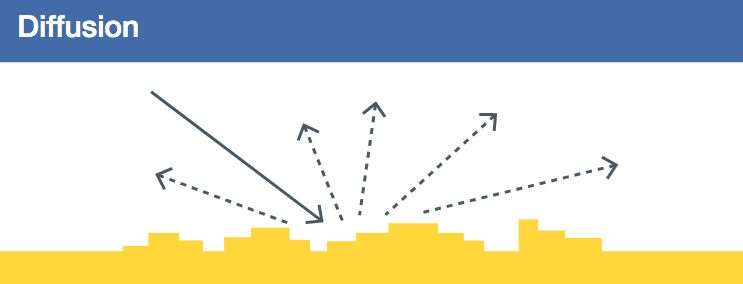
Diffraction
Diffraction is the bending of sound waves around objects. It occurs when the wavelength of the sound wave exceeds the largest dimension of the object. Instead of reflecting, some of the sound finds its way around the object. The lower the frequency of the sound, the more readily it diffracts.
If you were to have a friend stand behind a tree and speak, you’d likely still be able to hear and understand what they are saying. This is a simple example of diffraction. There is no reflective path that would carry the speech to you. Although some of the sound is reflected, much of it is diffracted because the diameter of the tree is small relative to the wavelengths of speech sounds.
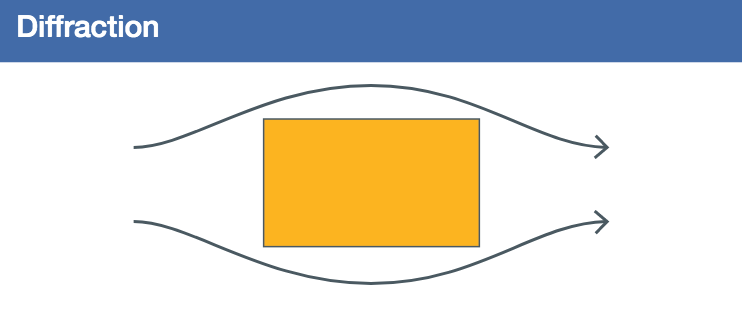
Refraction
Refraction is the bending of sound waves when they encounter a change in the speed of sound. This might be because they move from air to some other media (such as water), or it might happen entirely in air when the speed of sound varies when encountering air of changing temperature.
Read more about sound refraction.
Sound Barriers
One of the primary means of controlling noise in outdoor environments is through the use of sound barriers. Sound barriers are simply walls that are built between the source and receiver to block the direct path of propagation between the two. Sound tends to travel in a straight line, just like light. Like light, if we block that line of sight, we will get a shadow.

The effectiveness of a barrier depends on its height and distance from the source. Barriers work much better at high frequencies than low frequencies because of diffraction of sound over the top of the barrier. Diffraction is dependent on wavelength, and low frequencies have longer wavelengths. Controlling low frequency noise can require a very tall barrier.
Indoor Acoustics
Sound in a room creates millions of reflections, collectively called reverberation. The amount of reverberation in a room can affect—either positively or negatively—the success of the room for its intended purpose.
The absorptive characteristics of the surfaces and the objects in a room are the principal factors in determining how a room sounds. Sound that is absorbed when it hits a surface is not reflected back into the room. It might be turned to some other form of energy, such as heat or physical vibration, or it might simply escape from the room.
One of the biggest misconceptions in indoor acoustics is that materials that are good at absorbing sound will help to keep it from transferring from one space to another. This is not the case. Materials that are good sound absorbers are almost always very poor at preventing the transmission of sound from one side to the other. In fact, one of the best absorbers is an open window. The sound that hits the opening will obviously not be reflected back into the room. However, that sound still exists—it’s just outside.
When we are studying sound in a room, “absorbed” really means “not reflected.”
Sound Absorbers
There are three basic types of sound absorbers: porous absorbers, panel absorbers, and resonant absorbers. These three types vary in both the mechanism by which sound is absorbed and by the relationship between absorption coefficient and frequency. There are numerous designs of each, these are just some examples.
Porous Absorbers
Porous absorbers include soft, porous materials such as fiberglass, heavy drapery, or carpet, and convert sound energy to heat by trapping and slowing the movement of molecules. These are sometimes called frictional absorbers, because the transition from motion to heat is due to friction between the material and the air molecules.

The effectiveness of a porous absorber is principally dependent on its thickness. Thicker absorbers provide better low frequency absorption.
Panel Absorbers
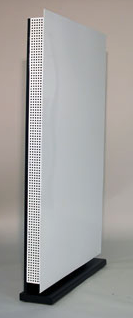
Panel absorbers—also known as flexural or diaphragmatic absorbers—consist of non-porous panels, generally separated from a rigid surface beyond it by an air cavity. These panels flex at their resonant frequencies, converting the sound energy to heat.
These absorbers are very effective for a bandwidth of about one octave, and can be designed for various frequencies of resonance and peak absorption.
Although panel absorbers can be intentionally designed to absorb sound for tuning of room acoustics, this effect is found in most drywall constructions as well. Simple walls constructed of wood or metal studs with drywall affixed to them tend to act as diaphragmatic absorbers. Some of the energy that is absorbed, however, typically makes its way through these lightweight partitions into the next room. This is an excellent example of a material that is good at absorbing sound but doesn’t isolate the sound very well. A wall stud shared by wall panels on both sides of it actually helps to transmit the sound through the wall.
Resonant Absorbers
A resonant absorber depends on the resonance of a cavity of air, generally known as a Helmholtz resonator. A bottle is a simple example of a Helmholtz resonator. If you blow over the top of an empty bottle, you’ll hear a particular tone. If you put some water in the bottle and repeat the experiment, the frequency of the tone will be higher. This is because the volume of the resonator has changed. If you were to build a wall out of these bottles, it would act as a very effective absorber at the particular frequency of resonance.
The bandwidth of effective absorption of a resonant absorber is dependent on the friction that the air encounters on its way into and out of the cavity. A soda bottle might have bandwidth of less than 1 Hz, but with a very high degree of absorption. The effectiveness of the absorption can be sacrificed in favor of a larger bandwidth. Adding porous absorption to the inside of the resonant cavity is a good way to achieve this.
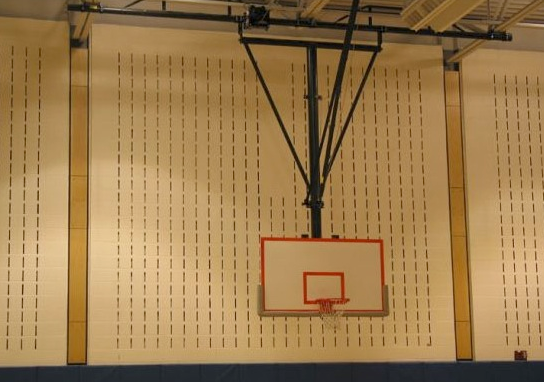
A popular resonant absorber product uses the cavities inside of cinder blocks for resonant absorption. In the photo, you can see the slots that allow the sound to get into the resonant cavities. These are manufactured with various resonant frequencies. By building a wall out of different blocks designed for several frequencies, broadband absorption can be achieved. The benefits of these absorbers over other types are impact and weather resistance. They are often used in gyms and swimming pool rooms.
Reverberation
Reverberation, because it is essentially random noise, will hinder speech intelligibility if it is too loud relative to the direct path. In spaces where speech communication is the most important goal, reverberation times are generally kept short—under 0.5 seconds or so.
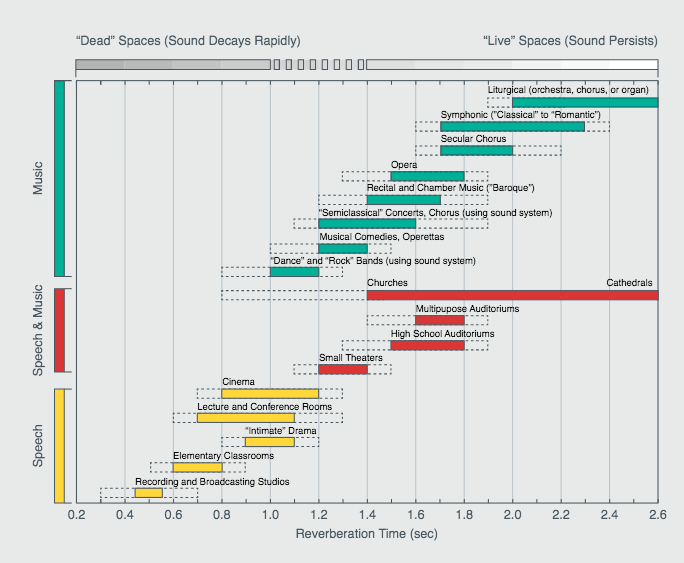
Music, however, often benefits from various amounts of reverberation. In fact, when music is recorded in small rooms with very little reverberation, it is often simulated electronically to make it sound like it was recorded in a larger, more reverberant space. The desired amount of reverberation varies with genre of music. Chamber music sounds great in a large reverberant space, but the same room would be disastrous for rock music.
Isolated Acoustics
When people speak of the acoustics of a room, they are usually referring to the behavior of sound within the room. However, the transmission of sound from one room to another is equally important. In rooms designed for music performance and recording, it is critical to keep intrusive noise from traffic, airplanes, other studios, etc. from interfering. In apartment buildings, providing sound isolation between apartments is even more important than the room acoustics.
Sound isolation primarily depends on two basic factors: mass and decoupling. To achieve a high level of isolation, we need a lot of mass, and we need to avoid any rigid connection between one side of a wall and the other. This can be achieved in several ways.
If we were to measure the reduction in sound pressure level from one side of a wall to another in a real building, we might find that the levels are quite different from those measured in the laboratory. There are several factors that might account for this difference, including the size of the wall, the absorptive qualities of the rooms, and flanking paths. Flanking paths are paths that the sound can take from one room to the next without actually going through the wall in question.
Flanking Paths
Aside from the predictable corrections for wall size and absorption that, flanking paths can severely degrade the isolation between rooms. The image below shows several different ways that sound might get from one room to the next, other than taking the path through the wall.
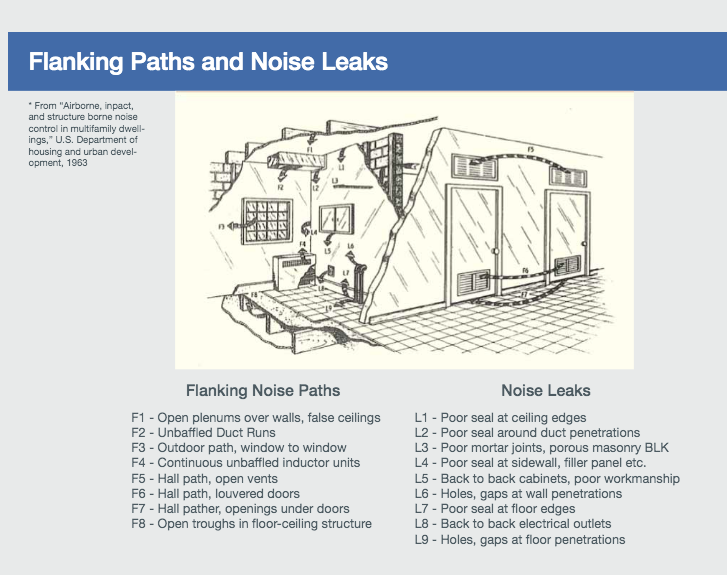
Although the image separates these paths into “flanking noise paths” and “noise leaks,” all are types of flanking paths. The leaks show the cases where the sound goes directly through holes in the wall into the next room.
Although only one or two of these paths might exist between a pair of rooms in a real building, it only takes one to degrade the effective isolation of the wall.
Small leaks tend to allow predominately high frequency sound through. This is because the wavelength of the sound must be short in order to fit through a small gap. It is important to be careful to seal up any leaks, however small, during construction. Making everything airtight will go a long way in avoiding this high-frequency infiltration.
The paths in the “flanking noise paths” list are indirect paths that the sound might take between one room and another. These tend to allow the invasion of a lower set of frequencies than the direct leaks.
Sound isolation between rooms is a critical component of acoustics. There are two basic measures of isolation—transmission loss and noise reduction—which we go over in depth in the 12-week Berklee Online course. Flanking paths can have a significant effect on this relationship, but we can generally predict the transmission loss of a wall in various bands.
I hope you found this excerpt from Berklee Online’s Acoustics course helpful. Like I mentioned, in the 12-week course, we’ll deep dive into the mathematical concepts that will help you predict how sound reacts in different spaces with accuracy.





